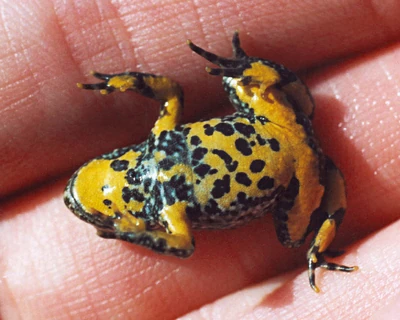
The Yellow-Bellied Toad (Bombina variegata) belongs to the order of Anura, the archaeobatrachial family of Bombinatoridae,
and to the genus of fire-bellied toads.
Anatomy[]
Adult: The larger of the males and females are between 35 and 55 mm, making them very small for Archaeobatrachians. Their top side is grey-brown, often with washed-out, bright spots. Their underside, including the inner sides of the limbs, fingers and toes is grey-blue to black-blue with striking, bright yellow to orange spots or patches, usually covering more than half of the underside. Yellow-bellied toads have a compact body - though not so flat as the related European Fire-bellied Toad - and a rounded snout. The pupils are heart-shaped, with the eardrums not visible. The overside has numerous warts with raised swirls.
The mating call of the males can be heard in late spring and early summer, a dull but melodic "uh... uh... uh" from their mating grounds. As the species does not have a vocal bladder, in contrast to the red-bellied toad, its call is quite gentle.
Spawn: The eggs are laid in loose clutches of 2 to 30 eggs in grass or often in patches of plants. The eggs are medium brown on the top side, bright brown on the bottom and measure on average 1.5 to 2 mm, while the jelly layer is 5 to 8 mm thick. The principal spawning time lasts from May to June.
Larva: At their highest the edges of the fins of the 55 mm long tadpoles reach to the middle of the body; the tail ends are rounded off. They are a dirty grey in colour and shine in all colours of the rainbow.
Distribution[]
The yellow-bellied toad is an amphibian closely bound to areas of water. Originally the species typically lived along brooks and rivers. It settled there dependent on the flood dynamic of temporary and continuously shifting small bodies of water. In its replacement habitats in human civilisation it is still dependent on temporary small bodies of water on loamy ground, such as tractor trails, puddles and small ditches. Mostly these areas are bereft of vegetation and free of competing species and predators. Through the quick heating of small bodies of water a rapid development of spawn and larvae is guaranteed. These pioneer species can be found mainly in quarries, clay- and gravel-pits and on marching grounds.
The superior mobility of the young of the species allows spontaneous settlement of newly discovered living spaces. On land the creatures look for hiding places under stones, dead wood and in the furrows and crevices of rocks. The yellow-bellied toad dwells in mountainous and hilly countries in middle and southern Europe. It is widely spread across the high hill area of middle and southern Germany and the Upper Rhine River Plains, but in few places.
Endangerment[]
- Loss of spawning grounds
- Continuation of the pioneer species
Legal protection status[]
- Special Area of Conservation – Schedules 2 and 4 ("Particular protection areas designated"; "Strongly protected")
- Bundesartenschutzverordnung (BArtSchV, Eng: Federal order of species protection) – Special protection
Introdution to the UK[]
These toads were introduced into the UK in the late 90's when trade brought 1000's of these toads into the UK for use as medicine, which is contained in the frogs mucus, and there was said to be lots that escaped into the wild. There are now breeding in small sites across the UK. They may be found in acidic bogs, such as peat.
https://www.froglife.org/info-advice/amphibians-and-reptiles/fire-bellied-toads/
